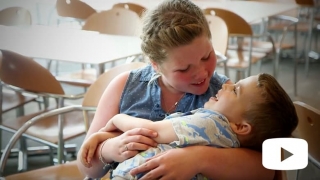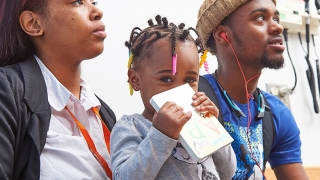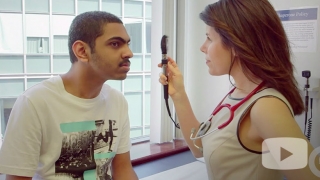Aicardi-Goutieres Syndrome (AGS)
What is Aicardi-Goutières syndrome?
Aicardi-Goutières syndrome (AGS) is a rare genetic disorder that affects the brain, spinal cord and immune system. It is a type of leukodystrophy, a group of conditions that affect the white matter of the brain. These diseases damage the myelin sheath, which surrounds and protects the nerve cells in the brain and spinal cord and speeds transmission of messages between cells.
In AGS, the body’s immune system turns on itself in a destructive way, targeting this white matter (myelin). It is the loss of myelin that is responsible for the symptoms of AGS. Most children with AGS end up with mild to severe intellectual or physical impairments.
Causes of Aicardi-Goutières syndrome
AGS is caused by a mutation in one or more of a small group of specific genes. The mutation leads to a buildup of small pieces of DNA in the brain, which is thought to trigger the immune response that leads to the symptoms of AGS.
Hear from AGS Families
In most cases, AGS is inherited. That inheritance occurs only when both parents carry the genetic mutation, generally with no symptoms themselves. (This is called an autosomal recessive pattern of inheritance.) Pairs of each of our genes are inherited, one from each parent. If only one copy of a gene’s pair has the mutation, a person will not present with symptoms of AGS, but will be a carrier of AGS. When two carriers have children together, the odds are one in four that any child they produce will have AGS.
Less often, AGS can be caused by a single mutation inherited from an unaffected parent. In rare cases, the gene mutation associated with AGS is not inherited from a parent. It is simply a random mutation and is new in the person who develops the syndrome.
Signs and symptoms of AGS
There are two forms of AGS: an early-onset form and a later-onset form. Symptoms for both begin in infancy, but at different times.
Symptoms of early-onset AGS
Infants with early-onset AGS have jittery behavior and poor feeding ability from birth. They also have neurological and liver abnormalities at birth, which can be detected through imaging tests. Early-onset AGS is the more serious form of the syndrome. The symptoms can become more severe over time, and can include smaller head size (microcephaly), liver inflammation, seizures and skin rashes.
Loss of myelin in early-onset AGS often leads to permanent damage to brain function, and to severe lifelong intellectual and physical disabilities.
Symptoms of later-onset AGS
Babies with later-onset AGS develop and behave normally for their first few weeks or months. When symptoms appear, they may include:
- Intermittent, unexplained fever
- Irritability or inconsolable crying
- Skin problems, including chilblains (rash, lesions, or swelling on fingers, toes and ears that get worse in cold weather)
- Weak or stiffened muscles
- Feeding difficulties
- A decline in growth of the head
- Developmental delays
- Seizures
In later-onset AGS, these symptoms may last for several months. They then generally lessen and stabilize, but may leave persistent neurologic difficulties. Additionally, the immune dysfunction associated with AGS can affect many other organs of the body, sometimes in a life-threatening manner. This can include the lungs, the liver, the heart, the skin, blood cells and the kidneys.
Testing and diagnosis
Diagnosis of Aicardi-Goutières syndrome is made based on the physical symptoms, imaging of the brain, cerebrospinal fluid testing and the results of genetic tests.
- Magnetic resonance imaging (MRI) of the brain is a key diagnostic tool of AGS, as it can detect patterns in brain tissue that are characteristic of the disease. When testing for AGS, your child’s doctor will look for areas of calcium buildup (calcifications) as well as shrinking or unusually small (atrophy) areas of the brain.
- Cerebral spinal fluid (CSF) testing can reveal an increase in immune system activity that is typically found in AGS. The test is done by analyzing fluid taken from the spinal cord. This test alone is not used to make a diagnosis of AGS, but if the results are positive they can lead your child’s medical team to look for other signs of the syndrome.
- Genetic testing can identify changes in one of the genes known to be associated with AGS. This analysis is done from a blood sample. The results, combined with other tests, can lead to a diagnosis of a specific type of AGS.
Treatment for Aicardi-Goutières syndrome
There is no known cure for AGS, but treatment is available to manage symptoms and to help keep children comfortable. Because children with AGS present with different symptoms, the treatment plan for each child is unique.
Some children with AGS need treatment for respiratory problems. Some need support with feeding, including therapy and special diets. Seizures may need to be managed with medication.
Children with AGS should also be monitored for:
- Signs of glaucoma (with a yearly test)
- Diabetes insipidus and underactive thyroid
- Specific problems with the heart and lungs, including pulmonary hypertension and inflammatory cardiomyopathy
- Problems with blood cells, in particular with platelets, which can cause an increased risk of bleeding
- Problems with the blood vessels of the brain
- Gradual problems with the bones such as scoliosis and dislocated joints, which may be associated with the motor problems in AGS
If detected, these conditions can all be treated by pediatric subspecialists.
Many children with AGS benefit from physical and speech therapy to combat weaknesses caused by neurological damage.
What to Expect
At Children’s Hospital of Philadelphia, your child’s care will be coordinated by our Leukodystrophy Center. Our multidisciplinary team provides advanced diagnostic testing, comprehensive clinical care, and the latest treatments available while we continue to seek new therapeutic options.
Clinical trials may also be an option. There are several clinical trials currently underway for AGS at Children’s Hospital of Philadelphia. Ask your doctor if these may be appropriate for your child. You can also find a list of ongoing studies at www.clinicaltrials.gov.
Follow-up care for AGS
Children with AGS need regular monitoring by neurologists, as well as ongoing therapy and coordinated care by other medical subspecialists as needed. Physical therapists can help your child maintain muscle tone and flexibility. Speech therapists can help them overcome feeding and language challenges.
Reviewed by Adeline Vanderver, MD


















